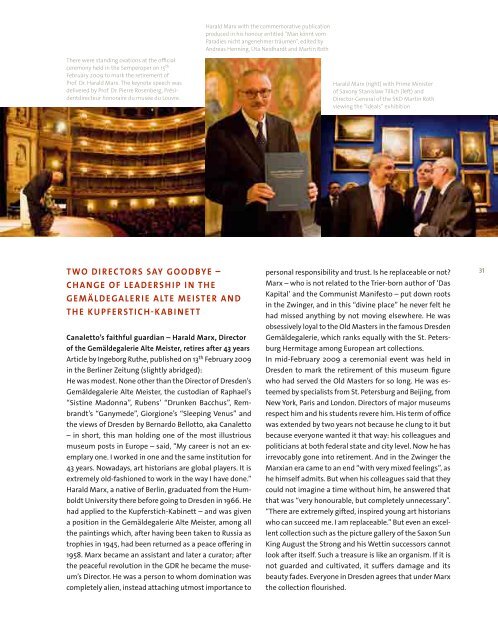2009 - Staatliche Kunstsammlungen Dresden
2009 - Staatliche Kunstsammlungen Dresden
2009 - Staatliche Kunstsammlungen Dresden
Create successful ePaper yourself
Turn your PDF publications into a flip-book with our unique Google optimized e-Paper software.
There were standing ovations at the official<br />
ceremony held in the Semperoper on 15 th<br />
February <strong>2009</strong> to mark the retirement of<br />
Prof. Dr. Harald Marx. The keynote speech was<br />
delivered by Prof. Dr. Pierre Rosenberg, Présidentdirecteur<br />
honoraire du musée du Louvre.<br />
tWO DI RECtORS SAY GOODBYE –<br />
CHANGE OF LEADERSH I P I N tH E<br />
GEMÄLDEGALERI E ALtE MEIStER AN D<br />
tH E KU PFERStICH-KABINEtt<br />
Canaletto’s faithful guardian – Harald Marx, Director<br />
of the Gemäldegalerie Alte Meister, retires after 43 years<br />
Article by Ingeborg Ruthe, published on 13 th February <strong>2009</strong><br />
in the Berliner Zeitung (slightly abridged):<br />
He was modest. None other than the Director of <strong>Dresden</strong>’s<br />
Gemäldegalerie Alte Meister, the custodian of Raphael’s<br />
“Sistine Madonna”, Rubens’ “Drunken Bacchus”, Rembrandt’s<br />
“Ganymede”, Giorgione’s “Sleeping Venus” and<br />
the views of <strong>Dresden</strong> by Bernardo Bellotto, aka Canaletto<br />
– in short, this man holding one of the most illustrious<br />
museum posts in Europe – said, “My career is not an exemplary<br />
one. I worked in one and the same institution for<br />
43 years. Nowadays, art historians are global players. It is<br />
extremely old-fashioned to work in the way I have done.”<br />
Harald Marx, a native of Berlin, graduated from the Humboldt<br />
University there before going to <strong>Dresden</strong> in 1966. He<br />
had applied to the Kupferstich-Kabinett – and was given<br />
a position in the Gemäldegalerie Alte Meister, among all<br />
the paintings which, after having been taken to Russia as<br />
trophies in 1945, had been returned as a peace offering in<br />
1958. Marx became an assistant and later a curator; after<br />
the peaceful revolution in the GDR he became the museum’s<br />
Director. He was a person to whom domination was<br />
completely alien, instead attaching utmost importance to<br />
Harald Marx with the commemorative publication<br />
produced in his honour entitled “Man könnt vom<br />
Paradies nicht angenehmer träumen”, edited by<br />
Andreas Henning, Uta Neidhardt and Martin Roth<br />
Harald Marx (right) with Prime Minister<br />
of Saxony Stanislaw Tillich (left) and<br />
Director-General of the SKD Martin Roth<br />
viewing the “Ideals” exhibition<br />
personal responsibility and trust. Is he replaceable or not?<br />
Marx – who is not related to the Trier-born author of ‘Das<br />
Kapital’ and the Communist Manifesto – put down roots<br />
in the Zwinger, and in this “divine place” he never felt he<br />
had missed anything by not moving elsewhere. He was<br />
obsessively loyal to the Old Masters in the famous <strong>Dresden</strong><br />
Gemäldegalerie, which ranks equally with the St. Petersburg<br />
Hermitage among European art collections.<br />
In mid-February <strong>2009</strong> a ceremonial event was held in<br />
<strong>Dresden</strong> to mark the retirement of this museum figure<br />
who had served the Old Masters for so long. He was esteemed<br />
by specialists from St. Petersburg and Beijing, from<br />
New York, Paris and London. Directors of major museums<br />
respect him and his students revere him. His term of office<br />
was extended by two years not because he clung to it but<br />
because everyone wanted it that way: his colleagues and<br />
politicians at both federal state and city level. Now he has<br />
irrevocably gone into retirement. And in the Zwinger the<br />
Marxian era came to an end “with very mixed feelings”, as<br />
he himself admits. But when his colleagues said that they<br />
could not imagine a time without him, he answered that<br />
that was “very honourable, but completely unnecessary”.<br />
“There are extremely gifted, inspired young art historians<br />
who can succeed me. I am replaceable.” But even an excellent<br />
collection such as the picture gallery of the Saxon Sun<br />
King August the Strong and his Wettin successors cannot<br />
look after itself. Such a treasure is like an organism. If it is<br />
not guarded and cultivated, it suffers damage and its<br />
beauty fades. Everyone in <strong>Dresden</strong> agrees that under Marx<br />
the collection flourished.<br />
31

















